
The Battle of Adwa was the climactic battle of the First Italo-Ethiopian War. The Ethiopian forces defeated the Italian invading force on Sunday 1 March 1896, near the town of Adwa. The decisive victory thwarted the campaign of the Kingdom of Italy to expand its colonial empire in the Horn of Africa. By the end of the 19th century, European powers had carved up almost all of Africa after the Berlin Conference; only Ethiopia and Liberia still maintained their independence. Adwa became a pre-eminent symbol of pan-Africanism and secured Ethiopian sovereignty until the Second Italo-Ethiopian War forty years later.

The Alpini are the Italian Army's specialist mountain infantry. Part of the army's infantry corps, the speciality distinguished itself in combat during World War I and World War II. Currently the active Alpini units are organized in two operational brigades, which are subordinate to the Alpine Troops Headquarters. The Alpini's name comes from their inceptive association with the Alps, the mountain range that Italy shares with France, Switzerland, Austria, and Slovenia. An individual soldier of the Alpini is called Alpino.

The 4th Alpine Division "Cuneense" was a division of the Royal Italian Army during World War II, which specialized in mountain warfare. The headquarters of the division was in the city of Cuneo, and the majority of its Alpini soldiers were drafted from the surrounding Province of Cuneo - hence the division's name "Cuneense". The division participated in all Italian World War II campaigns with the exception of the North African Campaign. The division was annihilated during Operation Little Saturn by Soviet forces in January 1943.
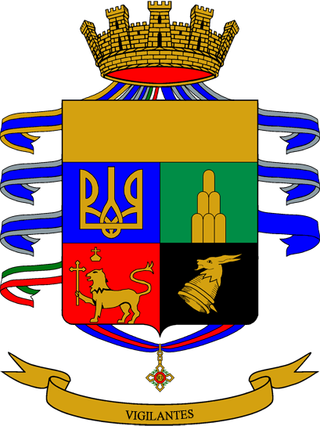
The 2nd Alpini Regiment is a regiment of the Italian Army's mountain infantry speciality, the Alpini, which distinguished itself in combat during World War I and World War II. The regiment was disbanded in 1943 due to losses on the Eastern Front, however one of its component battalions, the Alpini Battalion "Saluzzo", was reformed in November 1945 after the end of hostilities in Europe. The regiment itself was reformed in 1963 as a training unit, but during the 1975 army reform it was reduced to battalion. In 1992 the regiment was raised once again and today it consists of the Alpini Battalion "Saluzzo", is based in Cuneo and part of the Alpine Brigade "Taurinense".

The 7th Alpini Regiment is a regiment of the Italian Army's mountain infantry speciality, the Alpini, which distinguished itself in combat during World War I and World War II.

The 5th Alpine Division "Pusteria" was a division of the Royal Italian Army during World War II, which specialized in mountain warfare. The Alpini are a mountain infantry corps of the Italian Army, that distinguished itself in combat during World War I and World War II. The division was formed in 1935 and based in the Puster Valley, which gave the division its name.
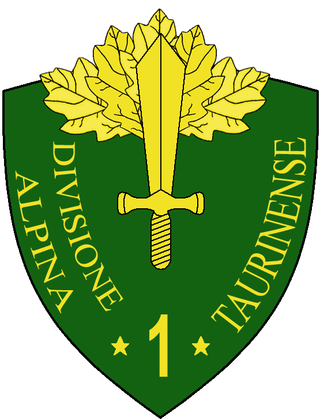
The 1st Alpine Division "Taurinense" was a division of the Royal Italian Army during World War II, which specialized in mountain warfare. The Alpini that formed the division are a highly decorated and elite mountain corps of the Italian Army consisting of both infantry and artillery units. Today, the traditions and name of the 1st Alpine Division "Taurinense" are carried on by the Alpine Brigade "Taurinense". The headquarters of the division was in the city of Turin and the majority of its soldiers were drafted from the surrounding Province of Turin — therefore the division was named "Taurinense" for the Roman name of the city of Turin Augusta Taurinorum.

Giuseppe Galliano was an officer of the Royal Italian Army, mostly known for his role during the First Italo-Ethiopian War. He perished in the Battle of Adwa and was posthumously awarded the Gold Medal of Military Valour.
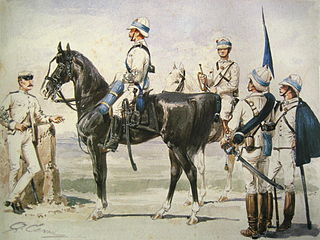
The Cacciatori d'Africa were Italian light infantry and mounted infantry units raised for colonial service in Africa. Cacciatori units later served in Somalia, Eritrea, Tripolitania and Cyrenaica for the Italian colonial empire. Partially mechanised in the early 1920s, the Cacciatori d'Africa remained part of the Regio Corpo Truppe Coloniali until 1942.

Giovanni Romero (1841-1896) was an Italian colonel who participated in several conflicts during the 19th century. He participated in the Second Italian War of Independence and the Third Italian War of Independence, most notably leading the 4th Africa Infantry Regiment during the Battle of Adwa of the First Italo-Ethiopian War before being killed at the battle. Romero was also a posthumous recipient of the Gold Medal of Military Valour.

The Regiment "Lancieri di Novara" (5th) is a cavalry unit of the Italian Army based in Codroipo in Friuli-Venezia Giulia. The regiment is the reconnaissance unit of the 132nd Armored Brigade "Ariete".

The Regiment "Cavalleggeri Guide" (19th) is a cavalry unit of the Italian Army based in Salerno in Campania. The regiment was the only Guides cavalry unit of the Savoyard state and later the Kingdom of Italy. Today the regiment is the reconnaissance unit of the Bersaglieri Brigade "Garibaldi". The regiment was formed in 1860 by the Royal Sardinian Army with pre-existing units. In 1866 the regiment distinguished itself in the Battle of Custoza. In World War I the regiment fought on the Italian front.

Emilio Battisti was an Italian general during World War II.

Domenico Turitto was an Italian major who was part of the Royal Colonial Corps of Eritrea. He participated in the Mahdist War as he commanded the 1st Indigenous Infantry Battalion, occupying the city of Kassala and distinguishing himself at the Battle of Kassala. During the First Italo-Ethiopian War, Turitto commanded the vanguard of the Indigenous brigade under the command of Matteo Albertone before being killed in the battle. He was also a recipient of the Silver and Bronze Medals of Military Valor and a knight of the Order of Saints Maurice and Lazarus.

Luigi Nava (1851-1928) was an Italian General of the Army who participated in the First Italo-Ethiopian War and World War I. He participated in the Italian colonial campaign in the Horn of Africa which lead to his participation at the Battle of Adwa, where he was wounded and taken prisoner by the Abyssinians. Having become Lieutenant General, at the action of the general mobilization of 1915 he was appointed commander of the 4th Army but was dismissed from the command four months after Italy entered the war.
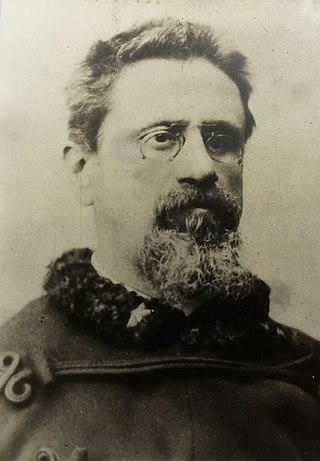
Cesare Airaghi (1840-1896) was an Italian colonel and war hero who participated in several conflicts during the 19th century. Airaghi participated in the Second Italian War of Independence, the Third Italian War of Independence and the First Italo-Ethiopian War before being killed at the Battle of Adwa.
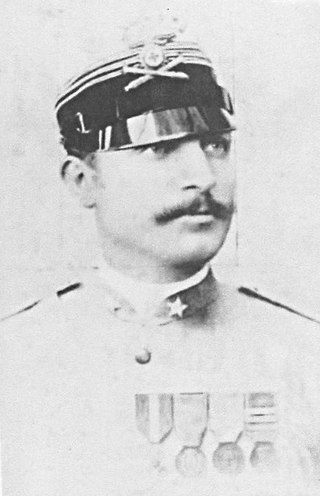
Edoardo Bianchini was an Italian captain of the First Italo-Ethiopian War. He commanded the 3rd Mountain Artillery Battery during the Battle of Adwa before being killed at the battle. He was also a posthumous recipient of the Gold Medal of Military Valor for his service at the battle.

Umberto Masotto (1864-1896) was an Italian Captain who served in the First Italo-Ethiopian War. He commanded the 4th Mountain Artillery Battery during the Battle of Adwa but was more famously known for being the first field gunner to receive the Gold Medal of Military Valour.
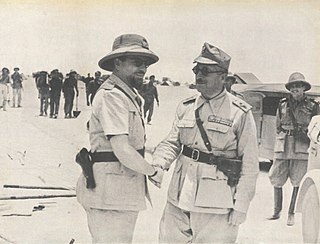
Luigi Sibille was an Italian general during World War II. At the outbreak of the war he commanded the 1st Libyan Division, also known as the "Sibille Division".

Giuseppe Antonio Baudoin was an Italian major of the Third Italian War of Independence and the First Italo-Ethiopian War. He commanded the 9th Africa Infantry Battalion during the Battle of Adwa before being killed in the battle. He was a posthumous recipient of the Gold Medal of Military Valour for his service in the battle.




















